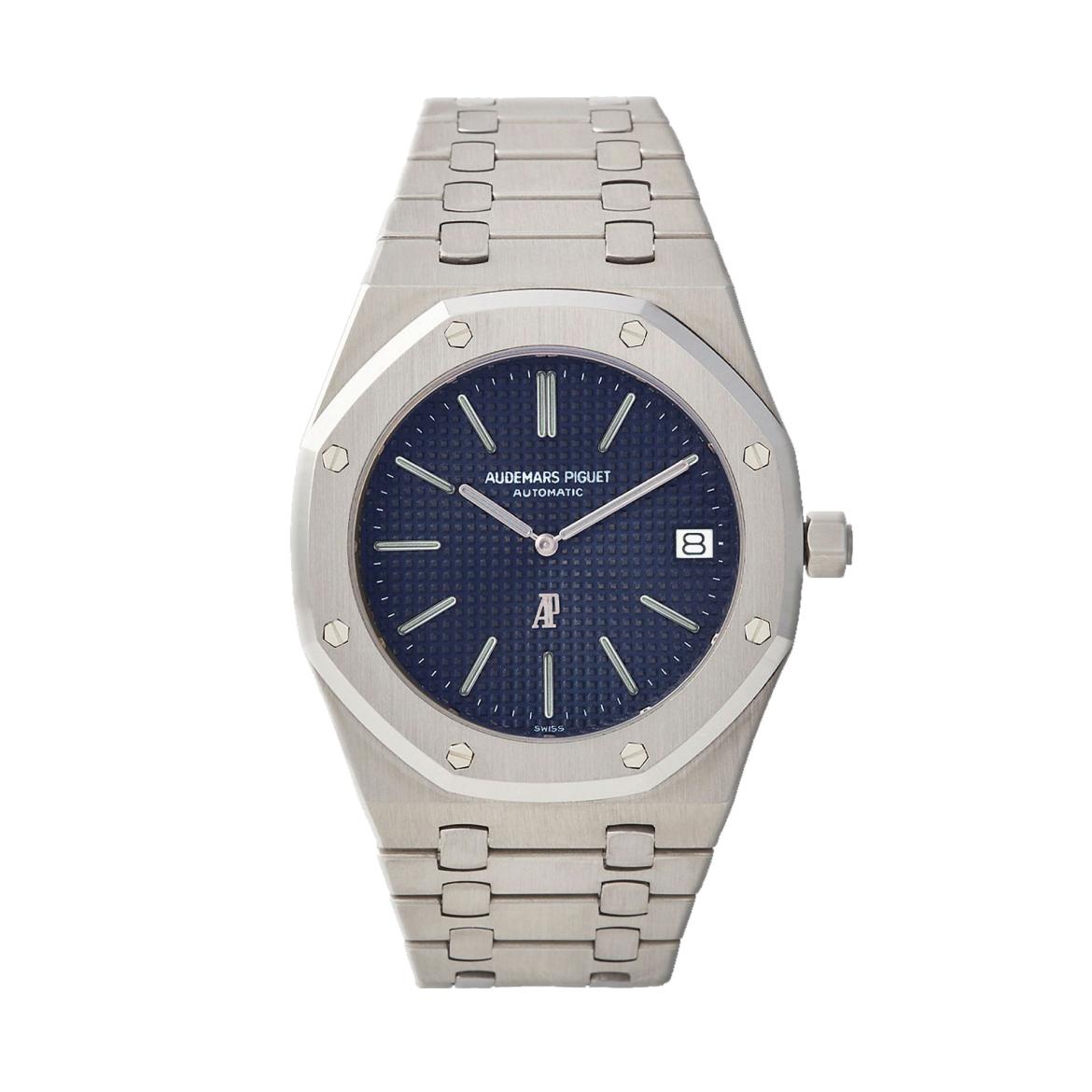Quick specs Audemars Piguet Royal Oak ref. 5402ST series A (1972)
Price 1972: approx. $ 850 | approx. € 825 | approx. £ 330 | CHF 3’300
Size: 39 mm
Reference: 5402ST
Year:
1972-1989 (5402ST A series, 1,937 pieces produced)
1972-1994 (5402ST all series, 4,288 pieces produced, including A series)
1972-2002 (5402 all series, 6,050 pieces produced)
Current value (good condition):
starting at around $ 65,000 | € 65.000 | £ 60,000 | CHF 60’000 (steel)
Table of contents first Audemars Piguet Royal Oak
- The history of the Royal Oak starts in 1972
- The design of the Royal Oak comes from Gérald Genta
- The case of the first Royal Oak just looks powerful
- Discarded old engraving machines for the dial
- Blue nuit dial for the Audemars Piguet Royal Oak ref. 5402ST
- Logo, hands and indexes of the Audemars Piguet Royal Oak ref. 5402ST
- The movement of the Audemars Piguet Royal Oak ref. 5402ST
- Bracelet of Royal Oak ref. 5402
- The Royal Oak 5402ST series A, B, C and D: what are the differences?
- Variants of the ref. 5402
- Price of the Audemars Piguet Royal Oak ref. 5402ST series A
- Technical data and specifications of the Audemars Piguet Royal Oak ref. 5402ST series A (1972)
The history of the Royal Oak starts in 1972
The first ever Audemars Piguet Royal Oak is the ref. 5402ST that is launched on the 15th of April 1972 at the Basel Fair in Switzerland. It is the so called A series, in steel (ST), and the first batch is about 1,000 pieces. After it sells out, a second batch of about 1,000 pieces is produced, also the A series, after which the B, C and D series would follow.
The model is also known as the Royal Oak Jumbo as its 39-millimeter diameter is huge in the 1970s. But the size is necessary for the combination of the case construction with screws, and space of the movement. Nowadays 39 millimeters is not really “Jumbo” and even back then the overall thickness of 7.15 millimeters wasn’t really big as well.
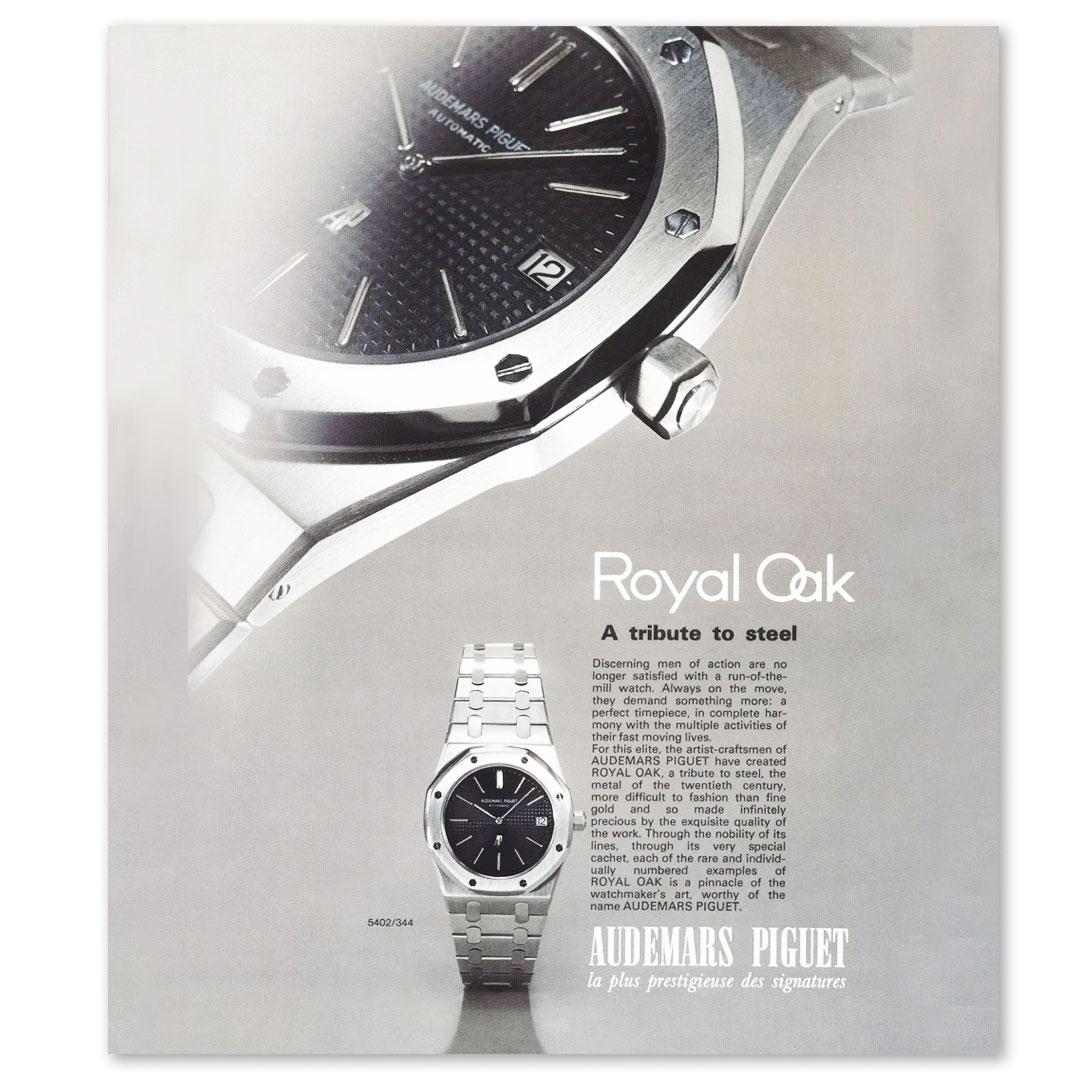
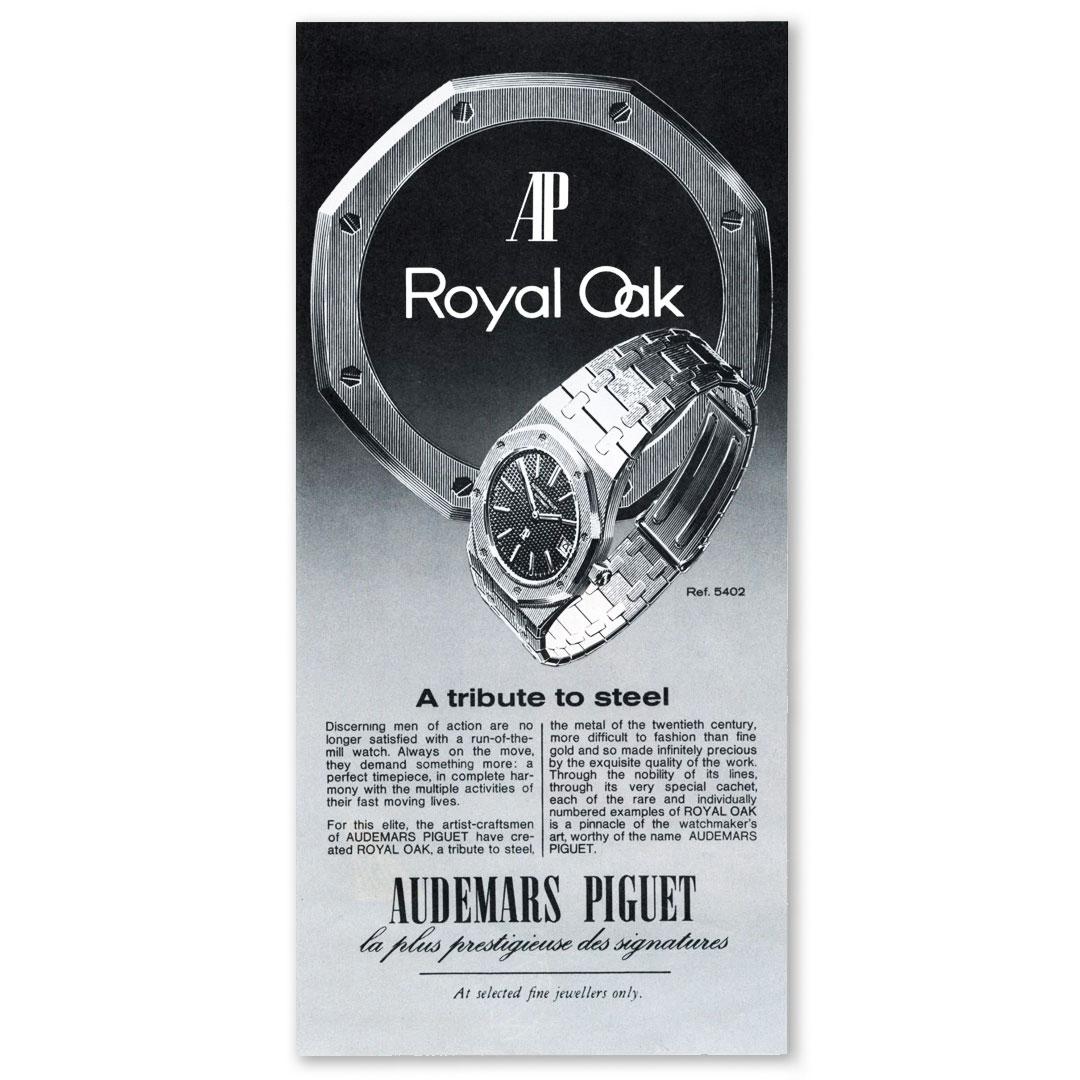
The design of the Royal Oak comes from Gérald Genta
The design of the first Royal Oak comes from the Italian-born designer Gérald Genta (1931–2011), later also responsible for the Patek Philippe Nautilus and revisited IWC Ingenieur for instance. Audemars Piguet and Gérald Genta were already working together since the 1950s and in the 1970s the brand was looking for a “sports watch”.
It would be a completely new chapter as the Royal Oak would become the first Audemars Piguet watch to be produced in series.
The case of the first Royal Oak just looks powerful
Just in the middle of the quartz crisis that was threatening the Swiss watch industry Genta comes with a bold design that beams mechanical resistance, technicality and solidity. A strong circular case with an octagonal bezel with eight hexagonal screws driven through the whole monocoque case and the oversized seal.
So, there is no separate (screwed) case back as the back is an integrated part of the case construction. The case middle, case back and lugs are one component carved from a single block of steel. To open it, you have to remove the top, which is the bezel. This so called monocoque construction, together with an oversized gasket compressed with the eight screws ensures the waterproofness of the Royal Oak (100 meters / 330 feet). And paired with a metal bracelet, it is demonstrating its rigid structure.

Discarded old engraving machines for the dial
Although the powerful case and bezel are the most eye-catching aspects of the first Royal Oak at first sight, the dial is certainly an important part of its overall design as well. The dial is a so called tapisserie design, small, truncated pyramids which are punctuated by extremely small diamond-shaped holes.
With this, unique light effects are created when admiring the dial under different angles and light circumstances. You can say that this tapisserie design is based on the Clous de Paris guilloché pattern as seen on many other watches.
This tapisserie design was originally created to decorate lighters, pens and cigarette boxes. Special engraving machines, also known as guilloché copying machines, from the Swiss dial maker Stern Frères, are able to produce these special patterns. Stern got these machines from a firm called La Nationale as they stopped using them, but Stern still saw some potential in these old machines.
Blue nuit dial for the Audemars Piguet Royal Oak ref. 5402ST
There were about 300 different patterns from which Gérald Genta choose 13 designs for prototyping. This was resulting in one final design called T21. Meaning “Tapisserie No. 21” and now known as “Petite Tapisserie”. For the color of the dial a dark blue hue was chosen. Too dark colors would dim the light effect of the dial, to light would probably undermine the powerful design.
So, the first color of the dial of the Audemars Piguet Royal Oak ref. 5402ST is a blue color is called “blue nuit” (night blue). However, it is indicated “Blue Nuit 1 + N50”. This N50, or Nuage 50, is a drop (cloud, “nuage” in French) of black added to the transparent liquid lacquer applied on the blue. As, apart from a galvanic treatment of the dial plate, this lacquer, or zapon, protects the dial against oxidation. Later, other dial colors would follow.
As the tapisserie comes from an artisanal manufacturing process no single dial is exactly the same. For example, between the center of the dial and the date window you can find either 9, 10 or 11 pyramids. The form can also differ, for instance due to the wear of the machines.
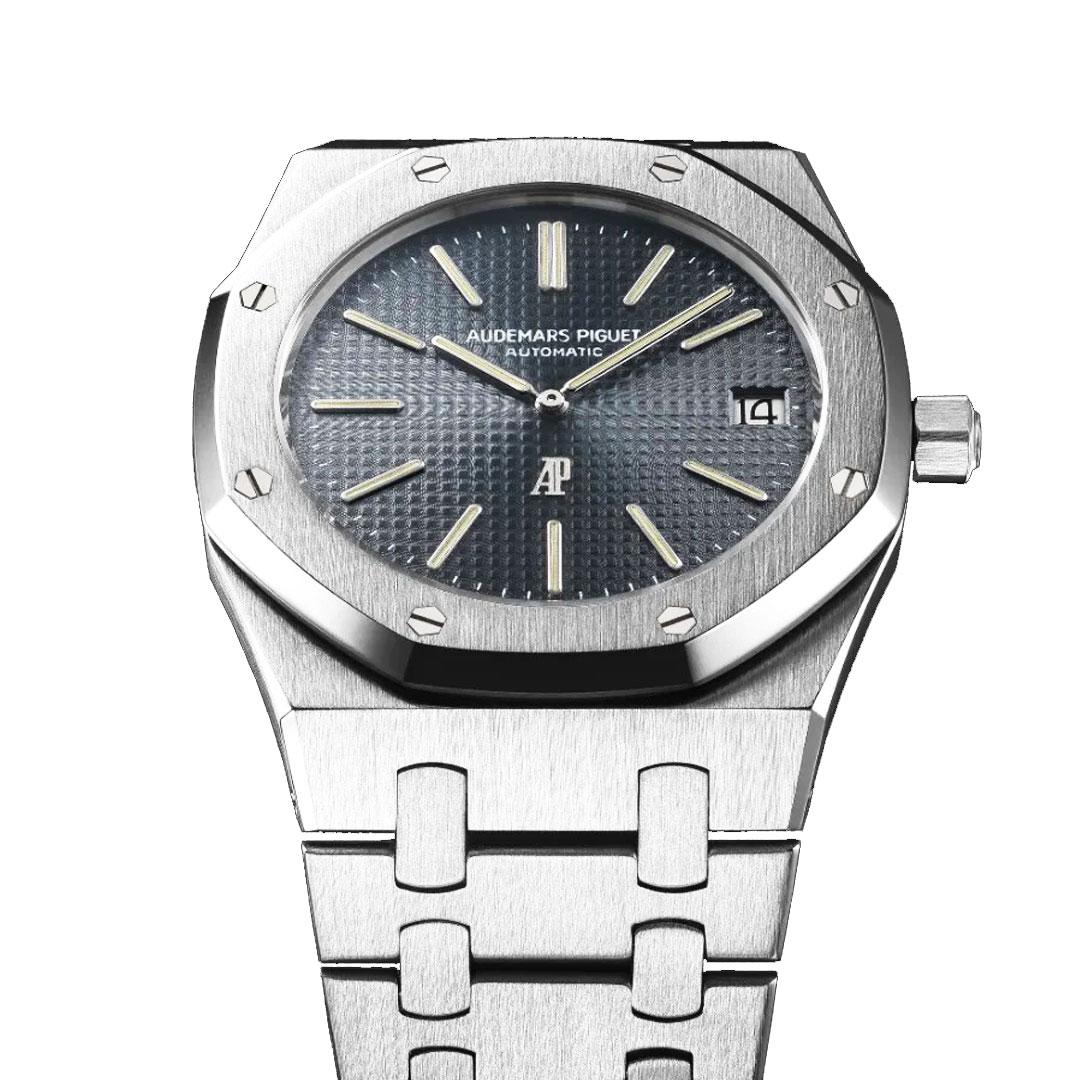
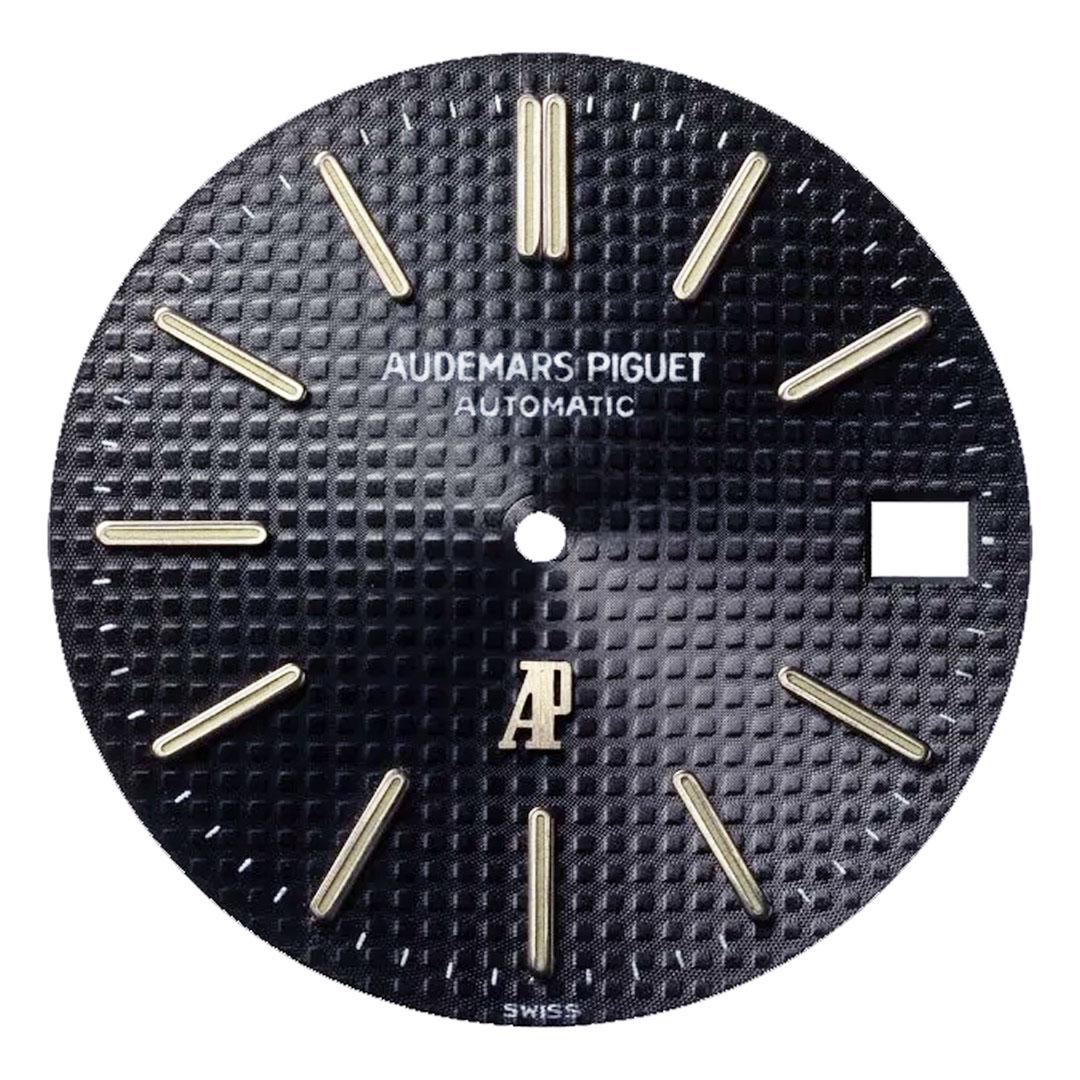
Logo, hands and indexes of the Audemars Piguet Royal Oak ref. 5402ST
The AUDEMARS PIGUET signature sits above the central ax of the hands, together with the AUTOMATIC indication. Then there is a date window at 3 o’clock. Around the markers is a thin white circle and between the markers a thin white minute track. Below 6 o’clock is SWISS. What would later change to SWISS MADE in the early 1980s. There are also examples of co-signed dials (by Tiffany & Co. for instance) but Audemars Piguet never registered who, what and where.
The satin-finished white gold AP monogram of the first 5402 is situated just above the 6 o’clock position, and dials with this are nicknamed “logo down dial”. In order to keep the 5402 as slim as possible the monogram only measures 12/100th of a millimeter in thickness. Leaving just enough room for the hands to move under the sapphire
In 1977 the monogram would move upwards, just under and also at the 12 o’clock position, but you can find logo down dials from later periods as the stock of old dials needed to be used up first.
The hands and indexes of the 5402 are gold, and the style is described as “baignoire” (French for “bathtub”). They are straight with rounded ends and hollowed out, just like a bathtub. In the beginning they are filled with tritium lume, later with luminova. Should a watch contain a certain amount of radioactive material one needs to print a “T” on the dial. If the level of radioactivity is less than 7.5 mCi no warning is needed, which is the case with the 5402. From 1999 the 5402 would get super-luminova. The hands of the 5402 are also flattened to keep the watch as slim as possible.
The movement of the Audemars Piguet Royal Oak ref. 5402ST
The movement of the Audemars Piguet Royal Oak ref. 5402ST is the Audemars Piguet caliber 2121, an automatic with a power reserve of 40 hours. It is based on the Audemars Piguet caliber 2120 from 1967.
This 2120 is an adjusted ultra-thin Jaeger-LeCoultre caliber 920 from the end of the 1960s, with a date function added. The 2121 that was created in 1970 stayed in production until 2021, underlining the quality of it.
Bracelet of Royal Oak ref. 5402
The 5402ST has a satin-brushed or polished tapering integrated stainless steel bracelet (ref. 344) with 154 components in 34 unique sizes. Which makes it, certainly given the period it is created, a piece of art by itself. The widest link measures 25.9 millimeters, the smallest 15.9 millimeters. Geneva-based firm Gay Frères designs it and would become the producer of these bracelets.
Depending on the length the 344 bracelet has 17 to 20 links in 12 different sizes and because of the wanted quality by Audemars Piguet they are very hard to produce in the 1970s.
Over time the 344 bracelet would evolve, the folding clasp as well. Things like the blades and cap would also change. Only specialist can really determine if a 344 bracelet is the original one belonging to a 5402ST.
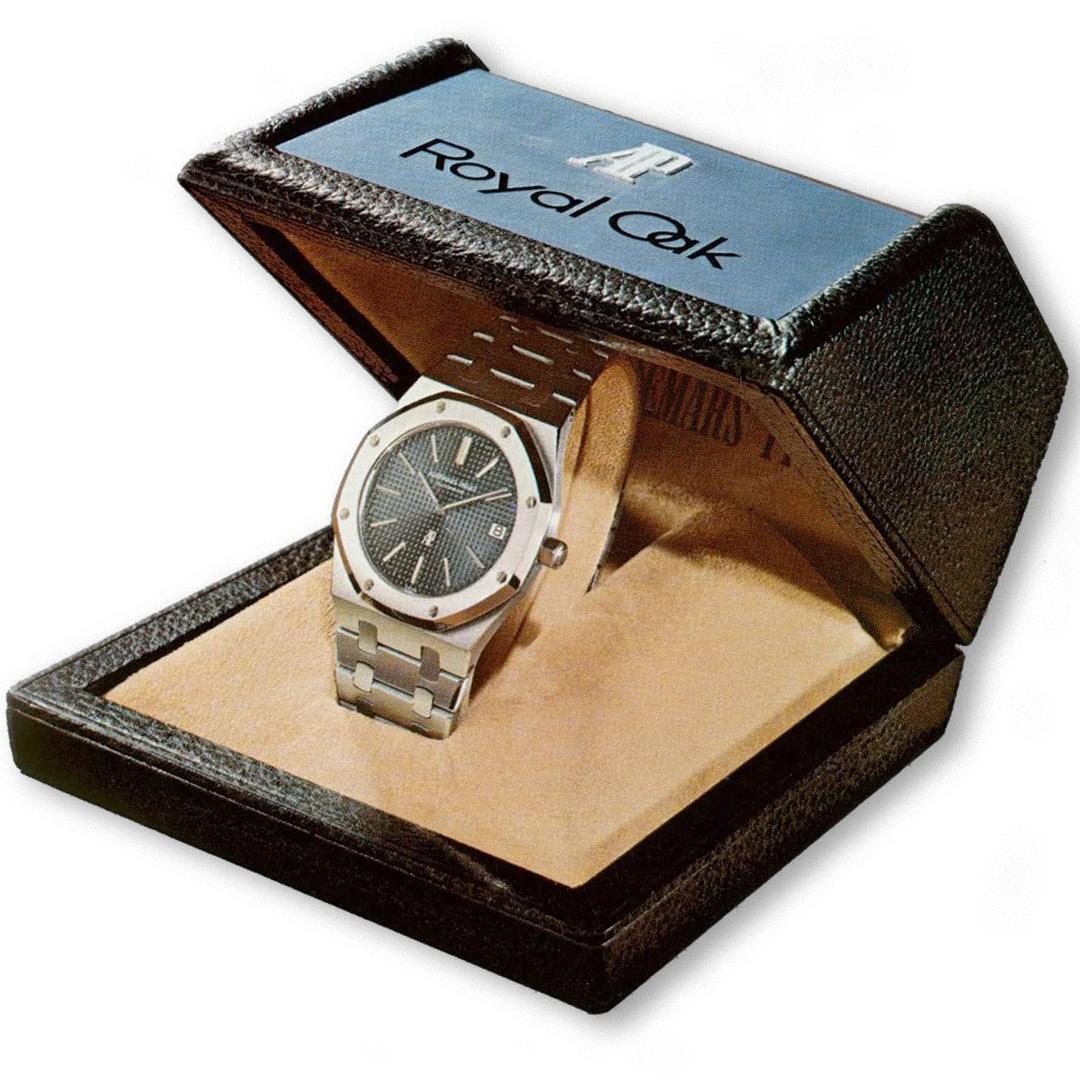
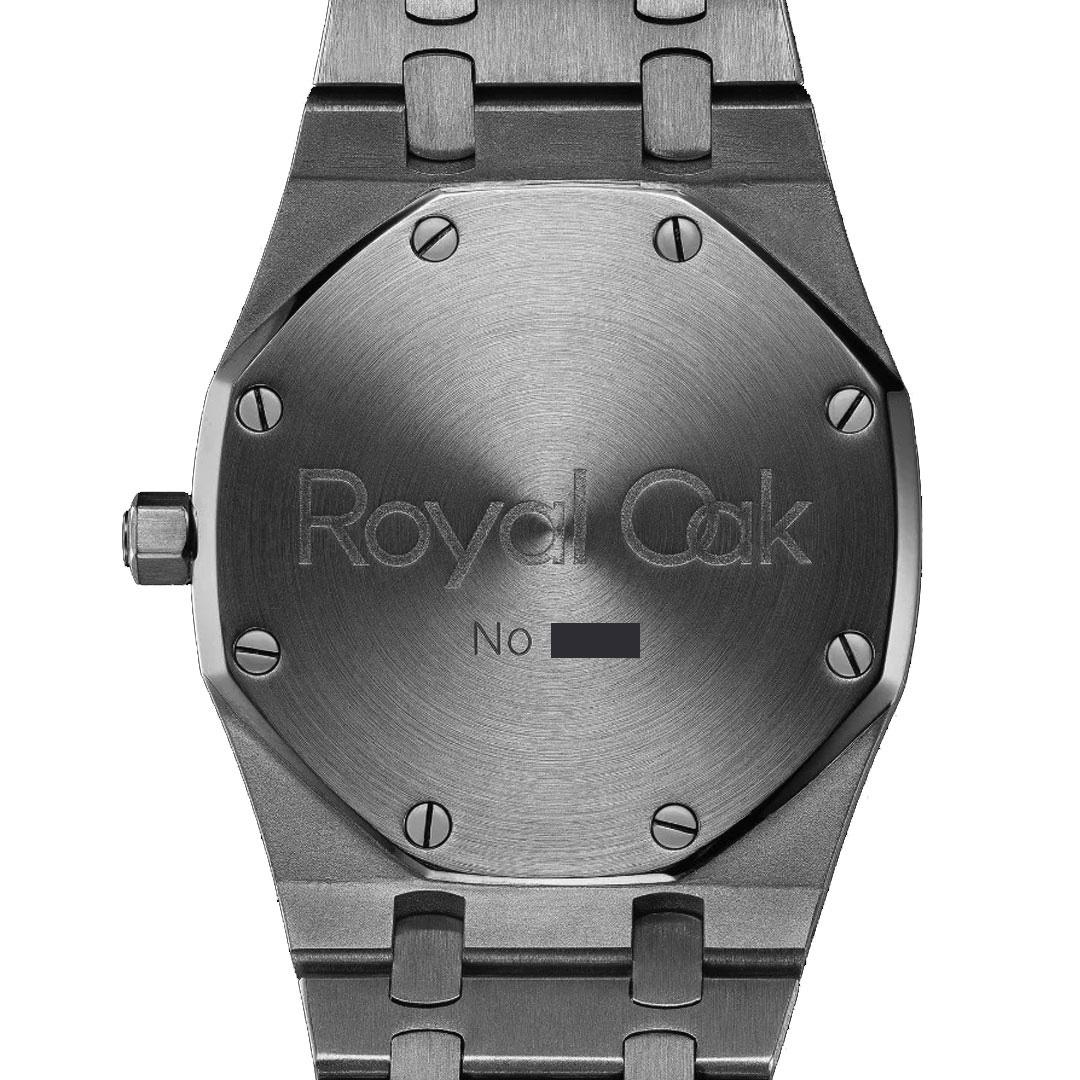
The Royal Oak 5402ST series A, B, C and D: what are the differences?
The first Audemars Piguet Royal Oak 5402 is the Series A in stainless steel, so the 5402ST. It is produced in two batches and the case back is marked with “A” plus a serial number (1 to 1999). The A series is produced between 1972 and 1975, 1,937 pieces in total. The brand sells this model until 1989.
This A is followed by the Royal Oak B series which has some slight refinements in production. But the overall design is similar to the A series. The B is produced between 1975 and 1976, 845 in total, and the case back is marked with “B” plus a serial number between 1000 and 2000. In 1993 the last one is sold. The dial is the same, although it is possible t have a replacement dial with the AP monogram at or just under 12 o’clock.
Then the Royal Oak 5402 Series C comes on the market in 1976, until 1978, and 952 pieces will be made. All marked with “C” plus a serial number between 1000 and 2000. There are some minor updates and refinements in the production techniques, the design is the same, except for the dial. There are slight variations in the dial texture and hue due to manufacturing differences. The last one is sold in 1987.
Finally, the Audemars Piguet Royal Oak 5402 series D which is produced between 1978 and 1980, 404 pieces in total. The case back is marked with “D” and the serial number (between 1000 and 1500). Again, there are some minor updates in production to ensure the consistency and quality of the model. The last D is sold in 1989.
There are also 129 models without a small case number, and 21 pieces without a letter, and these 21 are sold between 1988 and 1990.
Variants of the ref. 5402
Between 1977 and 1990 the first Audemars Piguet Royal Oak 5402BA is produced, a full yellow gold model, with 736 pieces in total. In the same year starts the production of the Royal Oak 5402SA, a two-tone model in steel and yellow gold. Until 2002 a total of 876 pieces will be produced.
Also, in 1977 AP starts the production of the Royal Oak 5402BC, a white gold version, some with 11 diamond hour markers. The model is in production until 1991, 150 pieces in total, however, already in 1972 one white gold piece is created for Shah of Persia, now Iran.

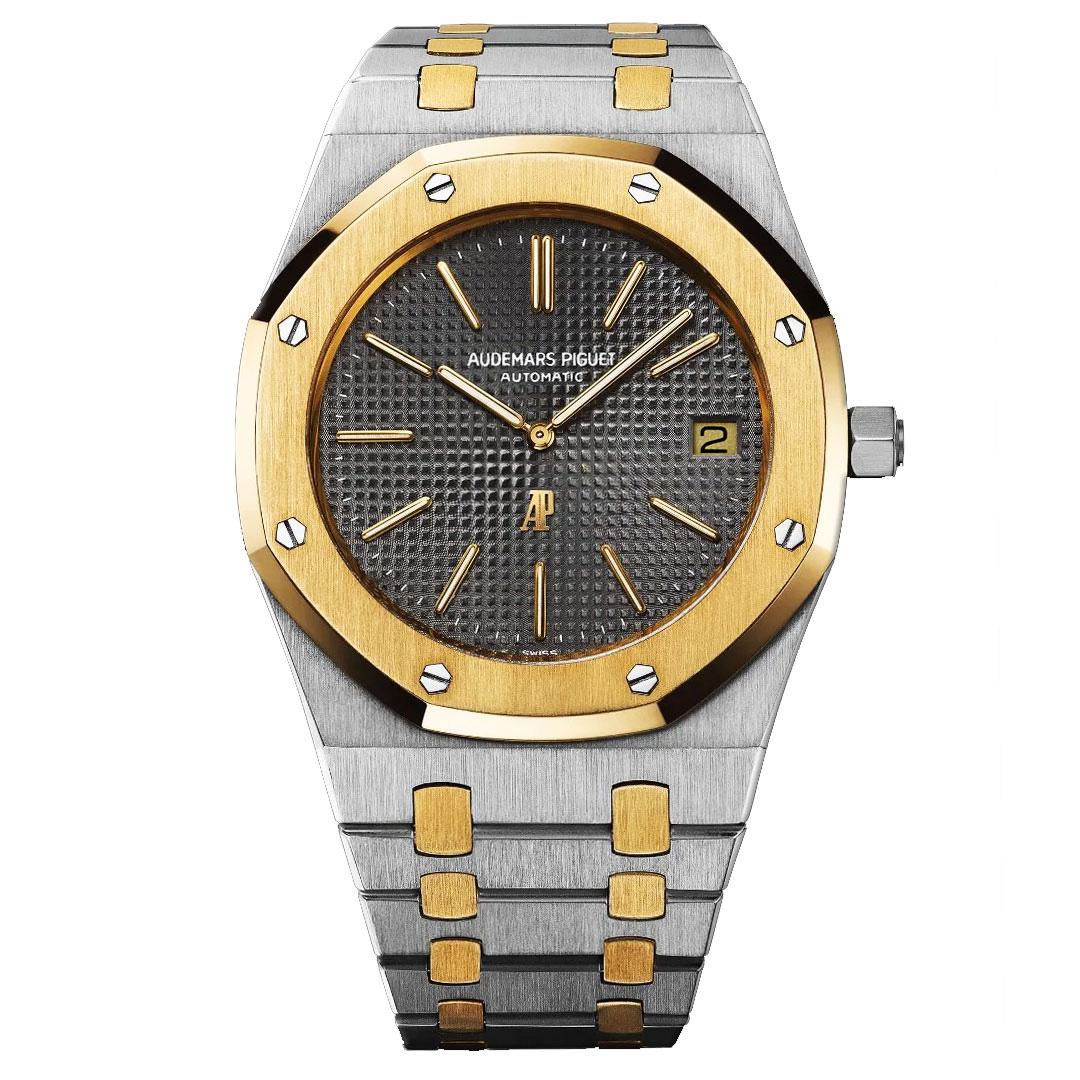
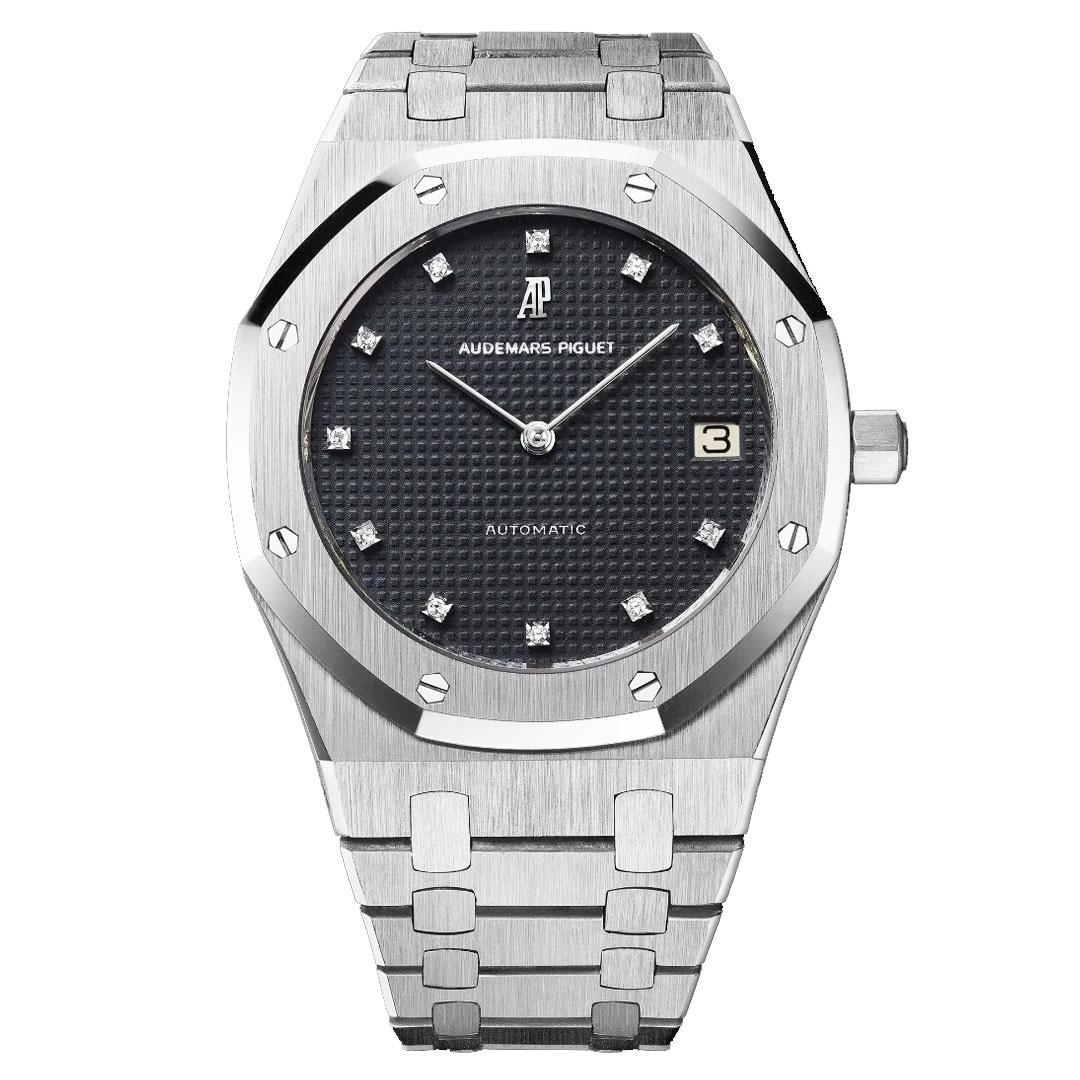
Price of the Audemars Piguet Royal Oak ref. 5402ST series A
The original price of the Audemars Piguet Royal Oak ref. 5402ST back in 1972 is CHF 3’300, the equivalent of around 850 dollars and euros, and 300 GB pounds. Which was quite a sum of money then. Today’s prices for an original 5402ST series A in good condition start at around 65,000 and go easily up to a 100,000. All depending on the condition of course.
Here you can read about the history of Audemars Piguet and the moment that Jules Louis Audemars and Edward Auguste Piguet join forces. And maybe you are interested in the first ever Rolex GMT-Master (the ref. 6542).
Technical data and specifications of the Audemars Piguet Royal Oak ref. 5402ST series A (1972)
| Reference: 5402ST |
| Movement: Audemars Piguet caliber 2121 (movement 127059) | Automatic | Diameter: 28 mm (12½ lignes) | Thickness: 3.05 mm | Frequency: 19,800 vph (2.8 Hz) | Parts: 247 | Jewels: 36 | Hours, minutes, date | Power reserve: 40 hours |
| Case and dial: 39 mm | Stainless steel monocoque (case 67026) | Thickness: 7.15 mm | Sapphire crystal | Blue Nuit 1 + N50 colored petite tapisserie (T21) dial | Applied satin-finished white gold AP monogram | Flattened gold hour and minute hands and applied indexes in baignoire style filled with tritium lume | Hexagon stainless steel crown | Stainless steel case back is part of the case | Water resistance: 10 ATM / 10 bar / 100 meters / 330 feet |
| Strap: Tapering integrated stainless steel bracelet (ref. 344) | Steel fold-over clasp |
| Price Audemars Piguet Royal Oak ref. 5402ST series A (1972): approx. $ 850 | approx. € 825 | approx. £ 330 | CHF 3’300 |
| Website: www.audemarspiguet.com |
